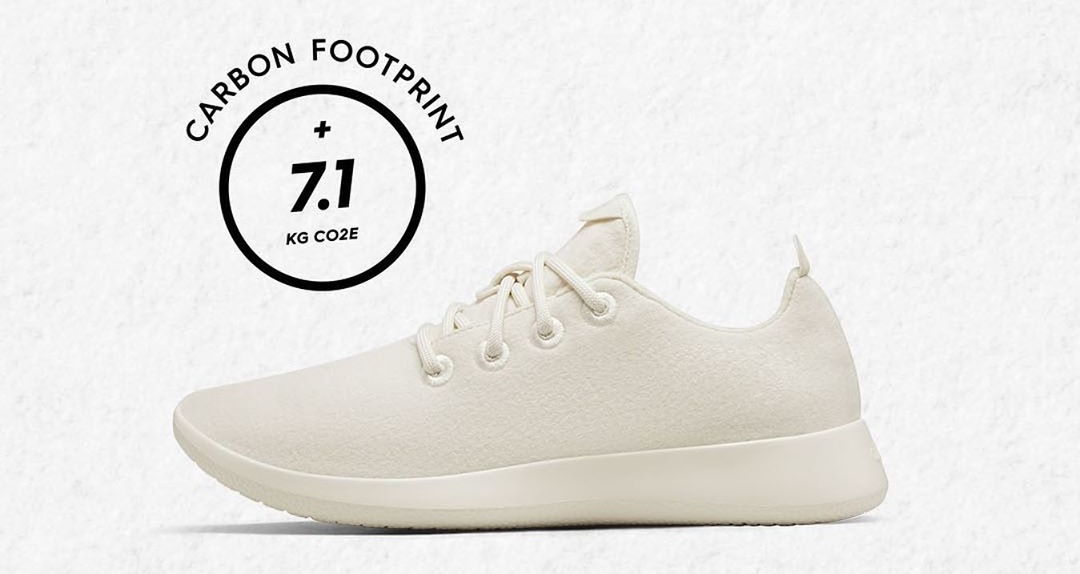
New Zealand-American footwear company Allbirds has been dedicated to environmental sustainability since its inception in 2016.
However, this year, it is taking its mission to the next level by introducing a carbon footprint label on each and every one of their products.
This makes Allbirds the first fashion brand to label every item it produces with its carbon footprint.
Beginning in April 2020, every new product Allbirds releases will include a number representing the CO2 that was required to produce it. In order to come up with this number, the brand developed a tool with the help of a third party group of carbon experts. The tool is able to measure the carbon intensity of every decision that goes into the creation of a style of Allbirds footwear, from the manufacturing, development, and materials, to packaging and shipping.
This will make it easy for consumers to know exactly how many carbon emissions were emitted in the creation of the pair of shoes they wish to buy.
The average carbon footprint of Allbirds’ products is 7.6 kg CO2e (for those that don’t know, CO2e means carbon dioxide equivalent emissions). To put this into perspective, 7.6 kg CO2e is equivalent to driving 19 miles in a car, running five loads of laundry in the dryer, or producing 22 chocolate bars.
By comparison, the average sneaker has a carbon footprint of 12.5 kg CO2e, and the average pair of jeans comes in at 29.6 kg CO2e. Thus, Allbirds’ sneakers already have a smaller carbon footprint than most of their footwear competitors.
Not all Allbirds’ footwear is 7.6 kg CO2e though. At the lower end of the spectrum are the Allbirds’ Tree Breezers (ballet pumps) which come in at just 5.3 kg CO2e, and at the higher end of the spectrum are the Runner-Up High Tops at 10.5 kg CO2e.
In addition to labelling each product with the total amount of carbon emissions required to create it, Allbirds is also providing a clear breakdown of how they reached that number. For example, the total of 7.1 kg CO2e it takes to make the Allbirds’ Wool Runner is broken down as follows: 5.7 kg CO2e from the materials used, 1.1 kg CO2e from the manufacturing process, 0.1 kg CO2e from use, and finally, 0.2 kg CO2e from the end of its life (i.e. when someone eventually throws them out).
In essence, Allbirds is putting their numbers on display for everyone to see, just as food companies are required to include nutrition labels on products. The level of transparency Allbirds is providing is unprecedented, and is part of the brand’s Carbon Fund initiative that was established in 2019. The fund is derived from the company’s self-imposed carbon tax and is put towards maintaining their own 100 percent carbon neutrality. It is also used to support carbon neutrality at large, by investing it in emissions reductions projects in the renewable energy sector.
Allbirds’ website reads, “Globally, the footwear industry emits 700 million tonnes of carbon dioxide each year. Even though we’re only contributing a tiny fraction to that number today, we think one tonne is still too many. And that’s why we’re going carbon neutral for our entire supply chain. That means, for every tonne of carbon we emit as a business—from the sheep on our farms to the lightbulbs in our headquarters—we’ll pay to take a tonne of carbon out of the atmosphere. It’s almost like we’re giving the planet an IOU, then immediately paying it back.”
Overall, the trendy footwear brand hopes that their carbon footprint labelling initiative, coupled with their commitment to 100 percent carbon neutrality, will inspire other fashion brands to make an effort to lower their own carbon emissions.
This article contains an affiliate link. Learn more.





